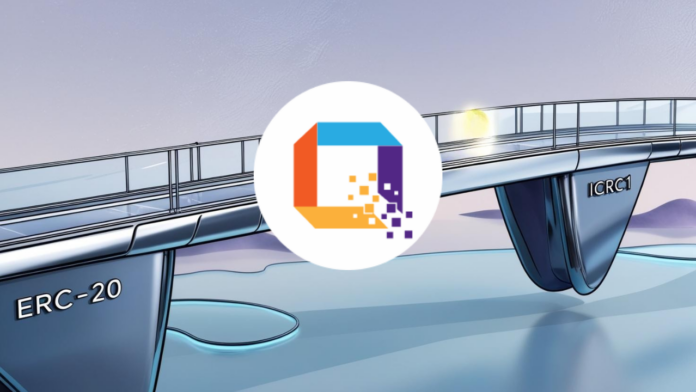Querio has thrown open the gates for users to make their move from ERC-20 to ICRC1 with the launch of its Bridge to ICP. Quietly confident and technically sound, the new feature lands with little fanfare, but its implications for token holders are immediate and practical. Querio has opted to make the transition simple, limiting each wallet to one transaction every 24 hours, and offering desktop-only access for now. It’s a choice that reflects a measured roll-out rather than a rushed leap, allowing users to test the system with a touch of patience.
The bridge itself serves as a literal and figurative crossing over into a new phase of the $QRO token’s evolution. In practical terms, it allows users to migrate their assets without friction, with transfer fees picked up by Querio. While many companies are quick to trumpet cost-saving measures, Querio appears more interested in building quiet trust through actual utility. No grand promises, just a functioning bridge that does exactly what it’s supposed to do.
There’s something refreshingly direct about the way it all works. There’s no gamified onboarding, no over-stylised explainer videos, just a link and clear instructions. One transaction per day keeps the system lean and avoids unnecessary pressure on either end of the bridge. This might feel slightly restrictive to those keen to move large volumes quickly, but it also signals a desire for control, accuracy, and low error margins. Querio is nudging users toward a calm, steady rhythm rather than chasing volume at all costs.
For existing $QRO holders, the move to ICRC1 isn’t so much a leap of faith as it is a strategic nudge. The shift into Internet Computer territory means quicker transactions, reduced fees, and the broader benefit of an ecosystem less burdened by congestion and carbon cost. Querio has clearly had this move in mind for some time. The groundwork for the bridge wasn’t laid overnight, and it shows in the level of polish. Everything has the quiet confidence of a project that has been tested well and thought through.
Though desktop-only access may feel like a nod to a more technical crowd, it’s also likely a tactical choice. Restricting the interface to larger screens gives users a chance to review transaction details without mobile distractions. With wallet safety and phishing still major concerns across web3 spaces, this seems like a choice made with an eye on user clarity and safety. Whether a mobile version is on the cards remains to be seen, but it would likely come later, once the process has proven itself at scale.
The decision to cover transfer fees stands out as more than a gesture of goodwill. It sends a message that Querio is backing the bridge with both hands, reducing barriers and friction to movement. This is, after all, a project still in a competitive stage of growth, where making things easier can mean everything. The fee coverage also subtly lowers the perceived risk for users curious but cautious about making the shift.
Querio has been operating in a fast-moving field, and like others in the space, it has to balance ambition with execution. Too many projects in the blockchain space over-promise features, then deliver half-built tools that leave users frustrated. Querio, by contrast, seems to be playing a different game. By focusing on small but reliable steps—bridges that work, fees that don’t surprise, limits that are intentional—it positions itself as a builder, not a broadcaster.
The mechanics of the bridge itself appear straightforward enough. After connecting a wallet, users are guided through the process without jargon or bloat. It’s deliberately unflashy, more focused on getting you across than dazzling you along the way. That tone feels aligned with what Querio has shown in past updates—more substance, less theatre.
Of course, this move doesn’t happen in a vacuum. The broader web3 ecosystem is watching as more projects test their infrastructure against the efficiency of the Internet Computer. With on-chain storage, low-cost execution, and a different architectural model than Ethereum, ICP brings a distinct set of opportunities. For Querio, aligning $QRO with that infrastructure seems like a logical next step, especially if future plans include more interactive features or app-layer growth.
There’s a temptation, often, to wrap this sort of update in oversized language. To declare it a revolution or make grand declarations about the future. Querio doesn’t seem interested in that approach. Instead, the project speaks in the form of working tools. That’s what makes this update quietly interesting. There’s no marketing sleight-of-hand, no unnecessary flair—just a live bridge, limits clearly stated, with costs covered. That clarity alone separates it from a lot of its peers.
As adoption grows and the bridge sees more traffic, there may be updates or loosening of some of the current restrictions. Daily transaction limits could eventually scale with demand or user tiers. But for now, the experience is clean, minimal, and functional. Whether or not this will spark a broader move from ERC-20 to ICRC1 among users remains to be seen, but Querio has clearly placed its bet. The tools are there. The pathway is open.
For users still hesitant, the lack of a fee burden lowers the risk enough to justify testing the waters. And by starting with a slower cadence, Querio ensures any user issues can be spotted early, addressed quickly, and smoothed out before opening the floodgates. That type of foresight tends to build trust more effectively than a thousand banner ads or influencer videos.
It’s easy to overlook updates like these in the noise of the current crypto landscape, but they’re often the most telling. Querio’s bridge might not make headlines for its drama or scale, but it speaks volumes in its design. There’s an intentional quietness to it, a focus on detail over display, and that often makes the biggest difference long-term.
For now, the bridge is live. The fees are on them. And the waiting begins—not for hype, but for habits to shift, transactions to tick upward, and users to see if ICP really is the next best step for $QRO. Whether you’re already deep in Querio’s world or just wandering by, there’s a solid, fee-free bridge waiting. Just one crossing a day—easy does it.


